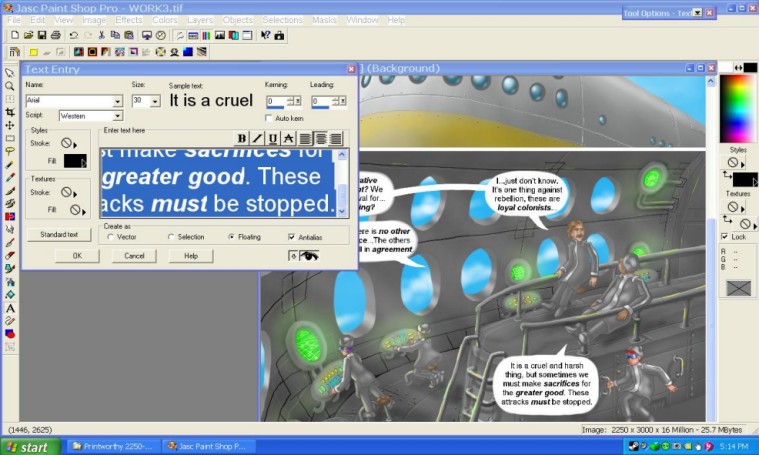
PASTEL
DEFENDER HELIOTROPE
How
The Comic Is Made, Page 7

Word balloons, and the tails that extend from them are added next. I I do this in Alias Sketchpad Pro, because it has a much finer control over the work, I find, than I feel I have in Paintshop Pro 7.

Once the word balloons are complete, I then move into Paint Shop Pro 7, because for all I enjoy Alias Sketchpad, it lacks one single important thing: the ability to place text. If Alias just had that one feature, I think I would have little need for any other paint program right now. I use Arial for my main font set to size 30. Some people complain about comics that use basic fonts like Arial, but frankly, I do not see the problem...Arial is extremely easy to read, is clear and precise, and has no connection to any specific time period...it makes a fine timeless font. I personally object to comics using fonts that are overly styled, because it reduces readability. I am not opposed to styled fonts per se, indeed a styled font can evoke mood and a sense of time and place... I just think they need to be easily readable. That comes first for me, and if there is ever a question about the issue, I will always default to the most readable font I can for a given situation, and let the art carry the time and place. I reason it this way; if the audience cannot read your text, you have no story.

Now as to dialogue and plot issues, you may be wondering about such matters as how the choice of balloon position and words are made. The answer is that I just put in balloons in places where they seem to fit and do not obscure too much of the artwork, and assign tails to the balloons pointing to which characters I have decided are talking to each other in a given scene. The size of the balloons are arbitrary, and based purely on intuition and what looks acceptable on the page, relative to the art.
When it comes time to write the dialogue, I just...write it. I know these characters, these people. I know their feelings, their histories, their likes and dislikes, their private lives. They are to me as if they were real people, after a fashion. So, I just sit down, and look at a balloon, and start typing. The voice of the characters talk in my imagination, and I record what they are saying as best I can. It just comes out. I don't think about it too much. That seems to spoil things. If I get nervous, and lose confidence, it spoils things. I need to feel like I am tapped into something beyond myself, unable to err, for a moment more than just me. I have to have a kind of unlimited confidence, and then it just spills out, and fits the balloons exactly.
Which is good, because I have a damaged memory, and I cannot remember my own stories over the time it takes to paint them, so I am grateful for whatever is happening in my subconscious mind that takes care of all the details for me. I am awful at trying to do outlines and sticking with them, I get bored and unable to follow my own script. Somehow it just works out when I do it this way. That is good enough for me!
With the writing done, all that remains is to save off one copy at high resolution in .Tiff format for any hypothetical future book deal, and then save off a reduced (33%) version in .Jpg format to be published on the web. I just enter WebExpress (a nice WYSIWYG website editor, no HTML experience needed) and load and place the images into my previously designed pages. And the final result, the finished, fully painted and scripted page 114 of my little graphic novel, is finally done:

This is page 114, entitled "The Soldier's Excuse", as it appears in the archives. A lot of work went into it, but I feel reasonably OK with the results. Of course no artist is ever completely happy with their own work (at least no artist I have ever met!), and when I look at this page, the errors and mistakes, and my own percieved failures of talent and ability literally leap out at me. It takes a month or so for me to forget my own work, and the process of making it enough to be able to look at a page such as this, and just for a moment, see it as though someone else had done it, with eyes unclouded with self-deprecation and hypertrophied criticism. Things I make look considerably better to me after a month or two. But they never seem to ever look good enough, no matter how much time has passed. Such is the life of the artist, I presume. Anyway, it is done.
Thank you for checking out how the comic is produced!

By
Jennifer Diane Reitz
![]()
A
Part Of Jenniverse.com
All
Website Contents, including all characters,
images,
artwork, text, and any other contents are
Copyright
© 2004 by Jennifer Diane Reitz
All
Rights Reserved Worldwide

Anti-Spam
Address Image
To
contact Jennifer you may use either of the above addresses.
You
may have to type them in yourself, if your browser does
not
support Javascript. Otherwise, click on the button!
LINK
FREELY
You
may link to this site freely!
You
may FREELY use any JENNYVERSE title image as a link button!